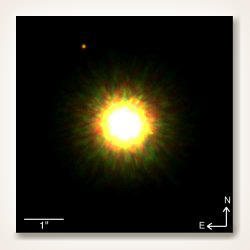Further study will be needed to prove that the planet is in fact orbiting around the star, as opposed to the possibility, however unlikely, that the two objects just happen to lie in the same area of the sky at roughly the same distance from us.
The researchers used the Gemini North telescope on Mauna Kea in Hawaii to glimpse the planet and its star, 1RXS J160929.1-210524, which lies about 500 light-years from Earth. Though the star has about 85 percent the mass of the sun, it is younger than our star. In order to image the far-flung system, the team utilized adaptive optics technology, which uses flexible mirrors to offset the distortion light suffers as it passes through Earth's atmosphere. |
 Credit: Gemini Observatory Credit: Gemini Observatory
|
The strange planet so far from its parent star is unexpected based on current theories of star and planet formation. For comparison, the farthest planet in our solar system, Neptune, lies only 30 times the Earth-sun distance away from the sun. The distant exoplanet, at about 1,800 Kelvin (about 1,500ºC), is also much hotter than our own Jupiter, which has a temperature of about 160 Kelvin (-110ºC).
"This discovery is yet another reminder of the truly remarkable diversity of worlds out there, and it's a strong hint that nature may have more than one mechanism for producing planetary mass companions to normal stars," said Ray Jayawardhana, of the University of Toronto. The team discovered the new planet as part a survey of more than 85 stars in the Upper Scorpius association, a group of young stars formed about 5 million years ago. The researchers have detailed the study in a paper submitted to the Astrophysical Journal Letters and also posted online.
|



